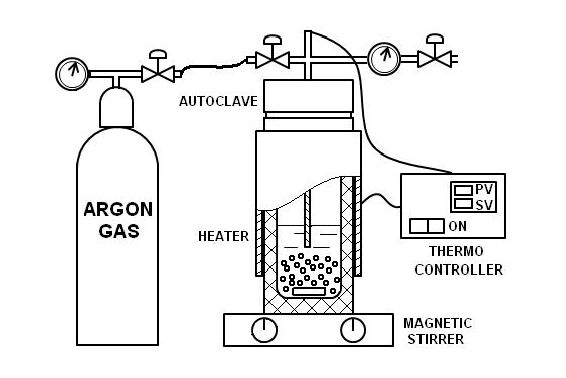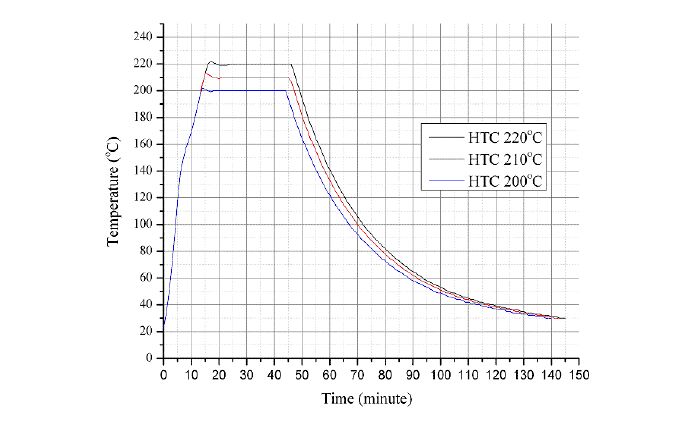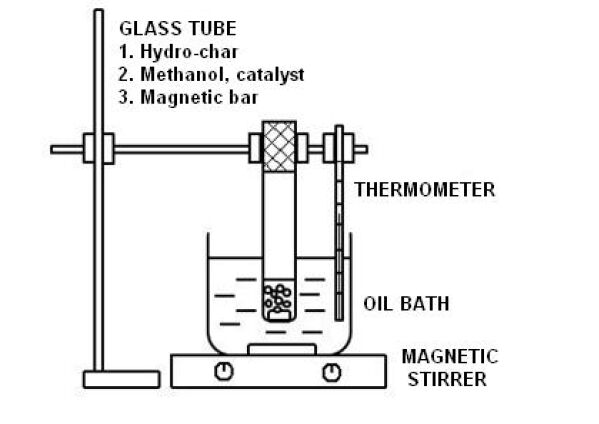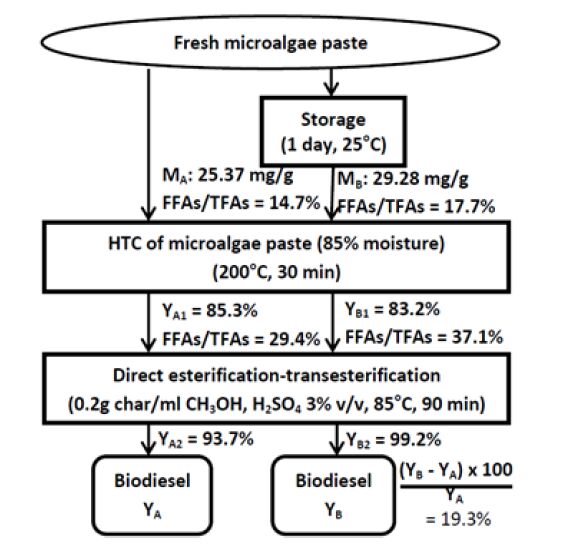1. Introduction
Recently, biodiesel from microalgae is especially concerned because microalgae can grow very fast, have high lipid content and can be cultivated at non-arable land or combined with sewage treatment [1]. However, due to very high moisture content of microalgae paste (approximately 80-90% w/w), drying of microalgae consumes so much energy. Furthermore, the treatment of a large amount of byproduct (lipid-extracted microalgae) is also another obstacle. One solution to these problems is the hydrothermal carbonization (HTC) process.
HTC of microalgae is a process in which microalgae react with water at high temperature (around 200 °C, 2 MPa) to form one solid product called hydrochar. Treatment of microalgae by HTC is very beneficial in terms of energy. For 10 kg microalgae paste with 90% moisture content, the energy required for complete drying is 23.31 MJ, while the energy required for performing HTC (without evaporation of water) and drying of the hydrochar is 7.83 MJ, only around 1/3 of the original value [2]. The heat of combustion of the lipid-extracted hydrochar was proved enough to provide the whole energy requirement of the HTC process and make the energy balance positive [2,3]. In comparison with a similar process of the hydrothermal liquefaction, HTC takes place in the milder condition, so it means that the energy requirement and the equipment cost will be considerably reduced. For example, in the hydrothermal liquefaction, a very high temperature (375 °C) should be required to get the maximum amount of bio-crude oil. Moreover, the bio-crude oil from the hydrothermal liquefaction consists of many various substances such as hydrocarbons, cyclic dipeptides, pyrroles, pyrrolidinones, free fatty acids, peptides, algaenan (polymethylens), algaenan derivatives, asphaltene, etc., has high viscosity and percentage of nitrogen, so these will add more cost to upgrade this oil before utilization [4]. On the other hand, after HTC of microalgae, two main products are obtained. While the aqueous phase, which contains the majority of N in the original microalgae, can be reused for cultivating microalgae [3,5], the hydrochar contains most of fatty acids, and it is a promising feedstock for biodiesel production [2,3].
Fatty acids in the hydrochar are bound fatty acids (BFAs) and free fatty acids (FFAs) as a result of the hydrolysis of BFAs during HTC [6]. One of the most effective methods to produce FAMEs from the hydrochar is a direct esterification-transesterification. Fatty acids (FAs) inside the hydrochar (both BFAs and FFAs) will directly react with methanol in the presence of a catalyst to form fatty acid methyl esters (FAMEs) without oil extraction. This approach eliminates a big amount of hazardous solvents required for oil extraction from microalgae such as chloroform and methanol [7], hexane and isopropanol [8]. Moreover, the biodiesel yield will be also improved compared to the traditional methods including the oil extraction and the subsequent transesterification [9,10,11]. Acid catalysts, the commonly used one is H2SO4, are usually used to catalyze both esterification of FFAs and transesterification of BFAs in one step.
In addition, the contents of TFAs and FFAs in microalgae paste increase with the storage time. In detail, there is an increase of FFAs along with a decrease of triacylglycerides (TGs, a form of BFAs) due to the hydrolysis of TGs under the effect of the enzyme lipase in microalgae [12,13]. The microalgae paste should undergo the HTC process to obtain the hydrochar used as a feedstock for biodiesel production. If the TFA content of microalgae is higher, the TFA content of the created hydrochar will be higher at the same HTC condition. However, if the FFA content of microalgae is higher, more FFAs will be extracted into the aqueous phase during the HTC due to the high solubility of FFAs in water at a high temperature [14]. Although most of these FFAs will be adsorbed again on hydrochar [3], a small part will be freely dissolved in the aqueous phase or adsorbed on the dissolved organic matters [15]. The higher the FFA content of microalgae is, the higher the possibility of losing these FFAs in the aqueous phase is. In other words, the TFA retention in hydrochar will be lower. There are two opposite effects on the TFA content of the created hydrochar. Therefore, in this work, HTC of stored microalgae has been conducted to see whether the amount of TFAs in the hydrochar increases compared to the hydrochar from microalgae without storage. In addition, the percentage of FFAs/TFAs is also evaluated in both cases. Because the acid catalyzed esterification of FFAs is much faster than the acid catalyzed transesterification of BFAs, the higher percentage of FFAs/TFAs will make the biodiesel formation faster at the same reaction condition. This additional storage step does not require chemicals or much energy, so it should be highly applicable.
2. Materials and Methods
2.1. Materials
2.1.1. Microalgae cultivation, harvest and storage
The marine microalgae species, Chlorella (PTCC 6010), was cultivated in the Rudic medium with the total volume of 120 liters [16]. The medium recipe was as follows, NaNO3: 300 mg/l, K2HPO4: 80 mg/l, KH2PO4: 20 mg/l, MgSO4.7H2O: 10 mg/l, CaCl2: 47 mg/l, EDTA: 7.5 mg/l, NaCl: 20 mg/l, H3BO3: 0.3 mg/l, MnSO4.H2O: 1.5 mg/l, ZnSO4.7H2O: 0.1 mg/l, (NH4)6Mo7O24.4H2O: 0.3 mg/l, CuSO4.5H2O: 0.08 mg/l, Co(NO3)2.6H2O: 0.26 mg/l, FeCl3.6H2O: 17 mg/l. The salinity of the medium was 30 g NaCl/l. The temperature was remained around 25 °C, and pH was adjusted around 8 by gaseous CO2. The microalgae density was determined by the UV-Vis spectrometer, and the microalgae medium reached to the stationary phase after 2 weeks and was ready for harvest. Microalgae were flocculated by FeCl3 with an amount of 0.3 g/l of the culture medium [17]. The flocculated microalgae were washed 2 times with water and then filtered to get microalgae paste.
The microalgae paste was divided into 3 parts after harvesting. The first one was dried immediately at 105 °C for 4 hours. The second and the third were stored in the incubator at 25 °C respectively for 1 and 2 days, and then dried at 105 °C after finishing the storage. Drying of microalgae enables the storage of microalgae and the accurate control of microalgae mass input in each experiment. In HTC, a certain proportion of dried microalgae and water was used to simulate the real moisture of microalgae paste. This protocol was just applied for the lab scale, and a fresh microalgae paste should be used for HTC in a commercial scale. The dried microalgae were also used in HTC in many previous researches [2,6,18].
2.1.2. Chemicals
All chemicals used in the microalgae cultivation, the harvesting and the direct esterification-transesterification reaction were purchased from Wako Pure Chemical Industries, Ltd. The fatty acid methyl ester standards including myristoleic acid, methyl ester (C14:1); tetradecanoic acid, methyl ester (C14:0); pentadecanoic acid, methyl ester (C15:0); 9-hexadecenoic acid, methyl ester, (Z) (C16:1); hexadecanoic acid, methyl ester (C16:0); heptadecanoic acid, methyl ester (C17:0) were purchased from Sigma-Aldrich.
2.1.3. Equipment
The UV-Vis spectrometer model was Shimadzu UVmini 1240. The 50 ml autoclave was purchased from Taiatsu Techno Corporation. The Tomy Multipurpose Refrigerated Centrifuge EX-126 was used to centrifuge samples. The Shimadzu GCMS-QP2010 SE was used to quantitatively analyze fatty acid methyl esters.
2.2. Hydrothermal carbonization of microalgae
HTC of microalge was conducted using the facility shown in Figure 1. Dried microalgae (3 g) and water (17 g) were supplied into the 50 ml autoclave. The ratio of microalgae and water was calculated to simulate the microalgae paste with 85% moisture content. One magnetic bar was used to agitate the mixture during HTC at 180 rpm. Next, the mini-autoclave was closed, and the argon gas was used to flush out the air inside.
The autoclave was heated to the desired temperature by a heating band and was held for 30 minutes. Preliminary experiments showed that when the HTC temperature was 190 °C or lower, or the holding time was 15 minutes, it was quite difficult to separate the hydrochar from the aqueous phase by filter papers. The reason is that the hydrochar size is not large enough. Hence, HTC was conducted at 200 °C, 210 °C and 220 °C, while the holding time was set at 30 minutes. This range of the HTC temperature and the holding time are appropriate for the HTC condition of microalgae [2,18,19]. Because there are no lignin, cellulose and hemicellulose in the microalgae composition, under a moderate temperature (around 200 °C) and time (< 1 h), microalgae can be converted into hydrochar [2]. After the holding time was reached, the autoclave was cooled down to the room temperature. The temperature profiles of the HTC experiments are shown in Figure 2.
The product mixture was filtered by the pre-weighed GF-A paper with the pore size of 1.6μm, and then the hydrochar was washed with 50 ml of distilled water. Next, the hydrochar and the filter paper were dried at 105 °C for 4 h. After that, the char was weighed and stored at 4 °C before conducting the esterification-transesterification experiments.
2.3. Direct esterification and transesterification of hydrochar lipids
The direct esterification and transesterification of hydrochar lipids were performed in a 10 ml glass tube shown in Figure 3. Firstly, the hydrochar (0.1 g or 0.2 g) and a magnetic bar were gently put into the glass tube, and the samples were prevented from sticking on the top of the tube. An amount of 1 ml methanol solution containing H2SO4 and the internal standard hexadecanoic acid methyl ester (C17: 0) of 100 μg was then added, and the tube was sealed by a teflon cap. The tube was then placed in a pre-heated silicone oil bath and underwent the esterification and the transesterification at 85 °C for 90 min with the stirring speed of 120 rpm. To reduce the amount of methanol, the maximum amount of hydrochar (0.2 g) was used corresponding to 1 ml of methanol, so two levels of 0.1 g and 0.2 g hydrochar/ml methanol were investigated. Sulfuric acid concentrations were investigated at 1, 2, 3 and 4% v/v of methanol. The temperature of the esterification-transesterification reaction was fixed at 85 °C, similar to the experiments for determining TFAs of microalgae [20].
When the reaction time was reached, 1 ml of distilled water was added to stop the reaction. Subsequently, an amount of 5 ml hexane was added into the tube to extract FAMEs. The mixture was shaken strongly and centrifuged at 2000 rpm for 5 minutes to completely separate the aqueous phase and the hexane phase. An amount of 1 ml hexane phase was pipetted to vials which were stored at 4 °C before the GC-MS analysis.
2.4. Quantitative analysis of total fatty acids (TFAs) and free fatty acid (FFAs) by GC-MS
2.4.1. Sample methylation for analysis of total fatty acids (TFAs)
The method determining the TFA content of microalgae (or hydrochar) was also based on the direct esterification and transesterification. Only 10 mg of microalgae (or hydrochar), instead of 0.1 g or 0.2 g, was used in this case, and the H2SO4 concentration was 2% v/v of methanol. The procedure can be referred above.
2.4.2. Sample methylation for analysis of free fatty acids (FFAs)
To determine the amount of FFAs of microalgae (or hydrochar), N, N-Dimethylformamide dimethyl acetal was used to selectively convert FFAs into FAMEs [21]. According to the Floch method, a mixture of 0.6 ml chloroform/methanol (2: 1, v/v) was utilized to entirely extract lipids of 10 mg microalgae (or hydrochar) [7]. The solvent mixture of chloroform/methanol was then evaporated completely at 60 °C. Next, 1 ml mixture of pyridine/N, N-Dimethylformamide dimethyl acetal (1: 1 v/v) were added to selectively convert FFAs into FAMEs at 60 °C for 15 minutes. After that, 4 ml hexane containing the internal standard hexadecanoic acid methyl ester (C17: 0) of 100 μg was added. Finally, the mixture was centrifuged at 2000 rpm for 5 minutes, and 1 ml solution was taken into vials which were stored at 4°C prior to the GC-MS analysis.
2.4.3. Quantitative analysis by GC-MS
FAMEs were analyzed by GCMS-QP2010 SE, Shimadzu, with the column Rtx-5MS, 30 m length, 0.25 mm diameter, 0.25 μm film thickness, and the splitless mode. The injector temperature was 300 °C, and the ion source temperature was 200 °C. The temperature program was as follows. The oven temperature was held at 40 °C for 3 minutes, increased to 180 °C at the rate of 20 °C /min, increased to 200 °C at the rate of 5 °C /min, held at 200 °C for 10 minutes, and increased to 300 °C at the rate of 20 °C /min.By using the internal standard method, the component concentrations were quantified by comparing the peak area ratio of each component with the peak area ratio of standard components. The concentration of FAMEs was the total of each component concentration.
2.5. Definition
Microalgae A: fresh algae, microalgae B: one-day-stored algae, microalgae C: two-day-stored algae
Hydrochar A from microalgae A, hydrochar B from microalgae B
Mass yield of hydrochar HA, HB
HA, % = (mass of hydrochar A × 100)/mass of treated microalgae A
HB, % = (mass of hydrochar B × 100)/mass of treated microalgae B
MA: TFAs of microalgae A (mg/g algae)
NA: TFAs of hydrochar A (mg/g hydrochar)
YA1: TFA retention of hydrochar A, %
YA1 = NA × HA/MA, %
YA2: yield of esterification and transesterification reaction of hydrochar A, %
YA: total biodiesel yield of the whole process from microalgae A to biodiesel
YA = MA × YA1 × YA2 (mg/g algae)
MB: TFAs of microalgae B (mg/g algae)
NB: TFAs of hydrochar B (mg/g hydrochar)
YB1: TFA retention of hydrochar B, %
YB1 = NB × HB/MB, %
YB2: yield of esterification and transesterification reaction of hydrochar B, %
YB: total biodiesel yield of the whole process from microalgae B to biodiesel
YB = MB × YB1 × YB2 (mg/g algae)
3. Results and Discussion
The major FAs of microalgae A are tetradecanoic acid, methyl ester (C14:0); 9-hexadecenoic acid, methyl ester, (Z) (C16:1); hexadecanoic acid, methyl ester (C16:0). This composition is similar to a marine Chlorella sp. in the previous research [17]. The TFA content and the C18 FA (stearic acid, oleic acid, and linoelaidic acid) content of this type of microalgae are low in the favorable cultivation condition [17]. In this research, the C18 FA content was very low, so it could not be detected.
Table 1. The effect of the storage time (one and two days) on total fatty acids (TFAs) and free fatty acids (FFAs) in microalgae.
| Fatty acid methyl esters |
Microalgae A
(mg/g algae) |
Microalgae B
(mg/g algae) |
Microalgae C
(mg/g algae)
|
| Myristoleic acid, methyl ester (C14:1) |
0.68 ± 0.02 |
0.88 ± 0.02 |
0.87 ± 0.04
|
| Tetradecanoic acid, methyl ester (C14:0) |
11.73 ± 0.27 |
13.28 ± 0.27 |
12.53 ± 0.61
|
| Pentadecanoic acid, methyl ester (C15:0) |
0.47 ± 0.01 |
0.49 ± 0.02 |
0.50 ± 0.02
|
| 9-Hexadecenoic acid, methyl ester, (Z) (C16:1) |
9.60 ± 0.19 |
11.64 ± 0.17 |
11.97 ± 0.53
|
| Hexadecanoic acid, methyl ester (C16:0) |
2.89 ± 0.08 |
3.00 ± 0.06 |
3.09 ± 0.15
|
| Total fatty acids (TFAs), MA, MB, and MC |
25.37 ± 0.56 |
29.28 ± 0.49 |
28.95 ± 1.10
|
| Free fatty acids / Total fatty acids (FFAs/TFAs), % |
14.7 ± 0.6 |
17.7 ± 0.3 |
18.4 ± 0.3
|
The percentage of FFAs/TFAs of microalgae A was 14.7%. Inherently, the microalgae have a certain concentration of FFAs. Robert B. Levine and et al., claimed that the FFA content in the dry microalgae (65 °C for 24 h) was 1-2% [6]. On the other hand, Tao Dong and et al. also reported that the FFA content of the lyophilized C. Sorokiniana was very high (46.85% of the TFAs) [22]. During the drying, the lipid hydrolysis by the enzyme lipase was inhibited at a high temperature [23] while the hydrolysis by heat was insignificant at 105 °C [24].
3.1. Effect of the storage time on total fatty acids (TFAs) and free fatty acids (FFAs) in microalgae
According to the data shown in Table 1, after the storage period of one day, the amount of TFAs in microalgae increased approximately 15.4% (25.37 to 29.28 mg/g microalgae) compared to the original. This difference is mainly due to the increase of fatty acids (FAs) of C14:0 and C16:1. In the second day, the TFAs gradually reduced a little. Microalgae maybe started to decompose. Meanwhile, there was a slight increase of FFAs/TFAs from 14.7% to 18.4%.
The slight increase of TFAs in microalgae B is consistent with the previous study [12]. The total lipid content of microalgae increased from 33.4% (stored at −80 °C) to 36.6% (stored at 25 °C) [12]. The phenomenon of slightly increased TFA content was also reported by E. Montaini and et al. when the microalgae Tetraselmis suecica paste was stored at 4 °C [25]. On the other hand, the increase of FFAs/TFAs is caused by the hydrolysis of triacylglycerides (TGs) in the presence of enzyme lipase inside the microalgae [12,13]. Due to the small difference between algae B and algae C, the algae B and the original fresh algae A were selected to be used in the subsequent HTC for the comparison.
3.2. Hydrothermal carbonization of microalgae
The mass yields of hydrochar after HTC of microalgae are shown in Table 2. The trend is that the higher the HTC temperature was, the less hydrochar could be obtained. However, the difference is negligible. The carbohydrate content of microalgae B is 36.2% which was determined by the colorimetric method [26].
Table 2. Mass yields of hydrochar after HTC of algae.
|
HTC (°C) |
Mass yields of hydrochar, %
|
| Algae A |
Algae B
|
| 200 |
57.1 ± 0.1 |
53.6 ± 0.3
|
| 210 |
55.3 ± 0.2 |
54.7 ± 0.5
|
| 220 |
52.7 ± 0.2 |
52.7 ± 0.3
|
Table 3. The TFA retention and FFAs/TFAs in hydrochar after HTC.
|
HTC (°C) |
Total fatty acids (TFAs) retention |
[(MB × YB1)- (MA × YA1)] × 100
/(MA × YA1) % |
Percentage of FFAs/TFAs
|
| Hydrochar A, YA1, % |
Hydrochar B, YB1, % |
Hydrochar A, % |
Hydrochar B, %
|
| 200 |
85.3 ± 1.1 |
83.2 ± 1.2 |
12.6 |
29.4 ± 0.8 |
37.1 ± 1.2
|
| 210 |
82.9 ± 0.5 |
78.4 ± 1.3 |
9.2 |
31.8 ± 2.7 |
38.0 ± 0.5
|
| 220 |
73.1 ± 2.4 |
70.8 ± 2.0 |
11.9 |
36.5 ± 0.8 |
39.3 ± 2.7
|
The TFA retention in the hydrochar after HTC is presented in Table 3. In general, the higher temperature was, the lower TFA retention was due to the enhanced hydrolysis of triacylglycerides (TGs) and the easy extraction of FFAs from microalgae into the aqueous phase under the HTC condition. At 200 °C, the retention level of TFAs was about 85%. This result is consistent with previous studies [2,19,27] which proved that the hydrochar of HTC at around 200 °C retained most of TFAs of original microalgae, from 80% to 95% depending on the type of microalgae.
According to Table 3, it can also be seen that hydrochar B had a little bit lower TFA retention compared to hydrochar A (YB1 < YA1) at all HTC conditions. The reason is that compared to microalgae A, microalgae B contained more FFAs which were more freely and easily extracted to water phase during HTC of microalgae due to the high solubility of FFAs in water at a high temperature [14]. Although most of these FFAs were adsorbed again on hydrochar [3], a small part was freely dissolved in the aqueous phase or adsorbed on the dissolved organic matters [15]. The higher the FFA content of microalgae is, the higher the possibility of losing these FFAs in the aqueous phase is. The higher percentages of FFAs/TFAs in hydrochar B also proved that. On the other hand, the amount of TFAs in microalgae B was 15.4% higher than the amount of TFAs in microalgae A (MB > MA) as mentioned above. Finally, the amount of TFAs in hydrochar B (MB x YB1) was still about 10% higher than the amount of TFAs in hydrochar A (MA × YA1) at all HTC temperatures. This result means that the additional storage step of microalgae paste can enhance the amount of TFAs in the subsequent hydrochar which favors for biodiesel production.
Meanwhile, the percentage of FFAs/TFAs tends to increase up to 40% as the temperature increases from 200 °C to 220 °C due to enhanced hydrolysis at a higher temperature. This is beneficial for the esterification-transesterification process because FFAs can be converted to FAMEs rapidly under the efffect of acid catalysts. However, it should be noted that when the temperature increased up to 220 °C, the TFA retention went down. Therefore, hydrochar A and hydrochar B formed at 200 °C were used in the direct esterification-transesterification process for biodiesel production.
Besides, it can be seen that the percentages of FFAs/TFAs of hydrochar B were higher than those of hydrochar A. This is because the hydrolysis of BFAs occurs slowly at first and then can be accelerated by the self-catalytic effect of formed FFAs [6]. Due to a higher percentage of FFAs/TFAs in microalgae B (17.7% > 14.7%), the hydrolysis rate of BFAs in microalgae B was faster than that in microalgae A at the same HTC condition, and more FFAs were formed in hydrochar B (37.1% > 29.4% at 200 °C). This facilitated the esterification-transesterification using the acid catalyst due to a rapid conversion of FFAs to FAME. It was proved that FFAs can even be converted selectively into FAMEs in the appropriate, mild conditions while BFAs are largely unaffected [28].
The elemental analyses for microalgae B and hydrochar B (200 °C) are shown in Table 4. The carbon content increased from 44.5% in microalgae B to 50.9% in hydrochar B (200 °C). The distribution of C and N in two phases is similar to the previous researches [3,5]. For the P distribution, most of P was retained in the hydrochar.
Table 4. The elemental analyses for microalgae B and hydrochar B (200 °C).
|
Microalgae B |
Hydrochar B (200 °C)
|
| C |
44.5% |
50.9%
|
| H |
7.2% |
6.9%
|
| N |
9.7% |
9.2%
|
Table 5. The elemental distribution in hydrochar B (200 °C) and the liquid phase.
|
Hydrochar B (200 °C) |
Liquid phase
|
| C |
46.1% |
53.9%
|
| N |
42.3% |
57.7%
|
| P |
98.5% |
1.5%
|
The energy balance of the process is calculated based on the HTC of 10 kg of microalgae paste with the moisture content of 85% (8.5 kg of water and 1.5 kg of microalgae) from 25 °C to 200 °C.
· The energy requirement for HTC of microalgae
The enthalpies of saturated water are 0.85 MJ/kg at 200 °C (473 K) and 0.10 MJ/kg at 25 °C (298 K) [29], so the heat capacity of water (from 25 °C to 200 °C) is (0.85 MJ/kg − 0.10 MJ/kg) = 0.75 MJ/kg. The heat capacity of microalgae is assumed to be a half of water in this range of temperature [2]. The energy for HTC of microalgae is (0.75 MJ/kg × 8.5 kg) + (0.75 MJ/kg × 0.5 × 1.5 kg) = 6.92 MJ.
· The energy requirement for drying hydrochar
The enthalpies of water are 0.42 MJ/kg at 100 °C (373 K) and 0.10 MJ/kg at 25 °C (298 K) [29], so the heat capacity of water (from 25 °C to 100 °C) is (0.42 MJ/kg − 0.10 MJ/kg) = 0.32 MJ/kg. The heat of vaporization of water at 100 °C (373 K) is 2.26 MJ/kg [29]. The mass of hydrochar B (HTC 200 °C) is (1.5 kg × 53.6%) = 0.804 kg. Because the moisture content of hydrochar B after the filtration is around 50%, so the mass of water is 0.804 kg. Finally, the energy requirement for heating and drying hydrochar B is (0.32 MJ/kg + 2.26 MJ/kg) × 0.804 kg = 2.07 MJ. The energy requirement for HTC of microalgae and drying hydrochar is (6.92 MJ + 2.07 MJ) = 8.99 MJ.
· Energy balance
The heating value is calculated based on the Dulong formula HHV (MJ/kg) = 0.338C + 1.428 × (H − O/8) + 0.095 × S [30]. For hydrochar B, the contents of C, H, O and S are 50.9%, 6.9%, 23.3% and 0.5%, respectively, so the heating value of hydrochar B is HHV1 = 23.0 MJ/kg. The heating value of biodiesel is HHV2 = 39.9 MJ/kg. Because the fatty acid content in hydrochar B is 0.045 kg/kg hydrochar, the energy balance is calculated as follows.
∆ = (23.0 MJ/kg × 0.804 kg − 39.9 MJ/kg × 0.804 kg × 0.045) − 8.99 MJ = + 8.02 MJ.
The energy balance is positive, so the heating value of lipid-extracted hydrochar is higher than the energy requirement for HTC process and drying hydrochar.
3.3. Direct esterification and transesterification of hydrochar
The yields of the esterification-transesterification reactions are presented in Table 6. Generally, the higher the H2SO4 concentration was, the higher the reaction yield was. To obtain the reaction yield exceeding 95%, the required H2SO4 concentrations were 2% v/v in the case of 0.1 g char/ml methanol and 4% v/v in the case of 0.2 g char/ml methanol. The methanol solution of 2% v/v H2SO4, with the same effect as the methanol solution of 5% v/v HCl, is normally used to prepare fatty acid methyl esters for chromatographic analysis [31]. This H2SO4 concentration was still sufficient for the case of 0.1 g char/ml methanol. However, when more hydrochar was used, 0.2 g char/ml methanol, the H2SO4 concentration should be higher, 4% v/v, to get the high conversion due to the absorption of H+ on functional groups such as -COOH, =CO, -OH (mainly) on the surface of hydrochar [32,33]. The absorption capacity was assessed based on the H+ exchange capacity [33]. The heavy metal cations were also absorbed on these functional groups, and the absorption capacity improved when the number of these functional groups increased [34,35].
Table 6. Yields of the direct esterification-transesterification reaction of hydrochar A (HTC 200 °C) and hydrochar B (HTC 200 °C) at 85 °C, 90min.
Hydrochar (g)
/ml methanol |
No. |
H2SO4 conc.
% v/v |
Hydrochar A
YA2, % |
Hydrochar B
YB2, % |
YB2 − YA2
% |
(YB − YA) × 100/YA, %
|
|
0.1 |
1 |
1 |
85.5 ± 0.3 |
94.4 ± 2.5 |
8.9 |
24.4
|
| 2 |
2 |
97.2 ± 0.4 |
98.0 ± 1.0 |
0.8 |
13.5
|
|
0.2 |
3 |
1 |
63.7 ± 0.8 |
72.6 ± 1.3 |
8.9 |
28.3
|
| 4 |
2 |
82.6 ± 0.6 |
88.7 ± 1.2 |
6.1 |
21.1
|
| 5 |
3 |
93.7 ± 0.4 |
99.2 ± 0.3 |
5.5 |
19.3
|
| 6 |
4 |
96.5 ± 0.5 |
99.0 ± 0.9 |
2.5 |
15.5
|
| YA = MA × YA1 × YA2(mg/g algae), YB = MB × YB1 × YB2 (mg/g algae) |
Moreover, at the same reaction condition, the reaction yields of hydrochar B were always higher than hydrochar A (YB2 > YA2). This is because the percentage of FFAs/TFAs of hydrochar B is higher than that of hydrochar A (37.1% > 29.4%) as mentioned above, and the acid catalyst H2SO4 can catalyze the esterification of FFAs much faster than the transesterification of BFAs [28]. Furthermore, the differences of the reaction yield (YB2 − YA2) being around the difference of the percentage of FFAs/TFAs (37.1% − 29.4% = 7.7%) also prove this explanation, excluding the cases using an amount of sulfuric acid more than necessary for hydrochar B (No.2 and 6).
Finally, the total yields YB (MB × YB1 × YB2) and YA (MA × YA1 × YA2) are compared as the ratio of (YB − YA) × 100/YA in Table 6. YB is always around 15%-25% higher than YA in all conditions of the esterification and transesterification reactions. For the case of 0.2 g char/ml methanol and 3% v/v H2SO4 concentration, the difference is 19.3%. The nitrogen content in biodiesel is 0.33%. In summary, the additional storage step of microalgae not only increased the amount of total fatty acids (TFAs) in the hydrochar product but also made the percentage of FFAs/TFAs higher as well as a higher reaction yield at the same reaction condition. This eventually leads to a higher total yield of the case including the storage of microalgae paste. The comparison of both cases is briefly illustrated in Figure 4.
4. Conclusion
An entire process, from the storage of fresh algae, the HTC of microalgae paste to the direct esterification-transesterification of hydrochar using the acid catalyst H2SO4, was investigated for biodiesel production. Instead of doing HTC of fresh microalgae immediately after harvesting, the storage of fresh microalgae for one day at the room temperature (25 °C) before conducting HTC can improve the total biodiesel yield of 19.3% at the same conversion conditions. This additional step is highly practical because there is no consumption of much energy and chemicals required in the storage of microalgae.
Acknowledgements
The authors thank the financial support from the scholarship of JICA, Japan Cooperation Center International, via Doctoral Degree Program in Japan of AUN/SEED-Net. In addition, the authors give many thanks to Abooali Golzary, Department of Environmental Engineering, Graduate Faculty of Environment, University of Tehran, for his enthusiastic guidance and support in cultivating microalgae.
Conflict of Interest
All authors declare no conflicts of interest in this paper.










 DownLoad:
DownLoad: 









